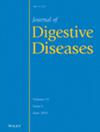Alexithymia in Functional Defecation Disorder: The Incidence and the Effect on Treatment
Abstract
Objective
We aimed to investigate the prevalence of alexithymia in patients with functional defecation disorder (FDD) and its impact on treatment outcomes.
Methods
FDD patients who underwent high-resolution anorectal manometry and balloon expulsion test were enrolled. Symptoms, anorectal function, and treatment efficacy were assessed at baseline and after 4-week medication.
Results
Alexithymia was present in 29.5% of all 129 FDD patients. Compared to the non-alexithymia group, the alexithymia group had higher baseline scores for the Patient Assessment of Constipation-Symptoms (PAC-SYM) (19.0 vs. 15.0, p = 0.03), Patient Assessment of Constipation-Quality of Life (PAC-QOL) (67.0 vs. 26.0, p < 0.001), Zung's Self-Rating Anxiety Scale (SAS) (44.5 vs. 30.0, p < 0.001), and Self-Rating Depression Scale (SDS) (48.0 vs. 33.0, p < 0.001). Moreover, the improvements in post-treatment complete spontaneous bowel movements (CSBMs) (0.0 vs. 1.5, p = 0.041), PAC-SYM (0.0 vs. −11.5, p < 0.001), PAC-QOL (0.0 vs. −16.0, p < 0.001), SAS (0.0 vs. −1.0, p < 0.001), and SDS (0.0 vs. −3.0, p < 0.001) scores were less significant in the alexithymia group than in the non-alexithymia group. A high Toronto Alexithymia Scale-20 score was an independent risk factor for drug therapy failure in FDD patients (odds ratio 0.949, 95% confidence interval 0.919–0.980, p = 0.001).
Conclusion
Alexithymia is prevalent in FDD patients and significantly affects symptom severity, quality of life, mental state, and treatment outcomes.


 求助内容:
求助内容: 应助结果提醒方式:
应助结果提醒方式:


